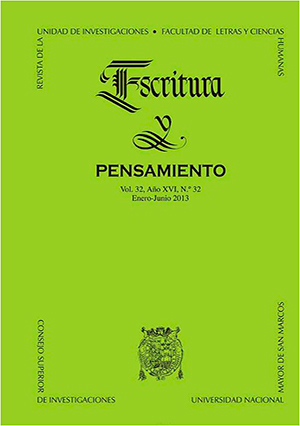NEW THEORETICAL AND EMPIRICAL PERSPECTIVES: THE DOUBLE POSSESSIVE OF THE THIRD PERSON
DOI:
https://doi.org/10.15381/escrypensam.v16i32.8013Keywords:
Speech variation among speakers, double possessive of the third person, School of Columbia, Ethnopragmatics.Abstract
In Peruvian Spanish the double possessive of the third person is observed in the speech variation among speakers in the following canonic form: article + N de + N (e.g., las primas de mi yerno) [literally, the cousins of my son-in-law] vs. possessive + N de + N (e.g., su hijo de mi hermana) [literally, her son of my sister]. We believe that this “redundant” genitive has expanded the function of removing ambiguity between two possessors and has begun a redistribution of semantic content as a significant signal, a specialized pragmatic tool or an intentional mechanism that expresses empathy in the face of an established relationship possessor-possessed. Our speech corpus is made up of interviews to Peruvian residents in Buenos Aires, a fact which has permitted us to distinguish between the meaning of the forms and the message in multi-cultural contexts. In that sense, the question “What comparative advantage would a community have for maintaining two alternating linguistic forms to refer to the third person?” acquires special relevance, if we bear in mind that the sample is composed of interviews to Peruvians who have been living for several years in Buenos Aires, Argentina. In other words, there is a spontaneous speech where an alternative use is kept, in spite of the years of contact with the variety from Río Plata, where the double possessive is unknown. The ethnopragmatic approach, in the light of the frequency of use of the forms (García 1995; Martínez, 1995; Martínez and Speranza, 2009) and the principles postulated by the School of Columbia about the communicative function of language (Diver, 1995; Contini-Morava, 1995; Otheguy, 1995) guided our methodological analysis.Downloads
Published
Issue
Section
License
AUTHORS RETAIN THEIR RIGHTS:
a. The authors retain their trademark and patent rights, and also over any process or procedure described in the article.
b. The authors retain the right to share, copy, distribute, execute and publicly communicate the article published in the Escritura y Pensamiento (for example, place it in an institutional repository or publish as part a book), with acknowledgment of its initial publication by Escritura y Pensamiento.
c. Authors retain the right to make a subsequent publication of their work, to use the article or any part of it (for example: a compilation of their work, lecture notes, thesis, or for a book), provided that they indicate the source of publication (authors of the work, journal, volume, number and date).





